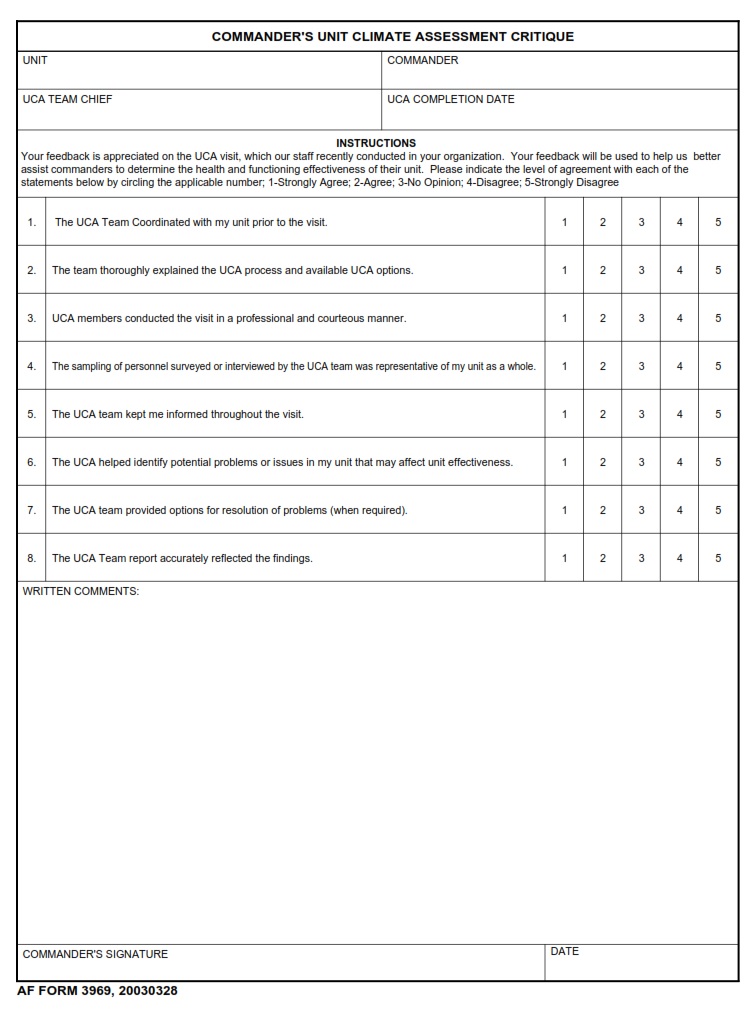AF-FORMS.COM – AF Form 3969 – Commander’s Unit Climate Assessment Critique – Have you ever wondered what goes on behind closed doors when it comes to evaluating the overall climate of a military unit? Well, brace yourself, because we’re about to take you on an exclusive behind-the-scenes journey into the inner workings of the AF Form 3969 – Commander’s Unit Climate Assessment Critique. This top-secret document holds the power to shape the morale and well-being of our brave soldiers. Join us as we uncover its secrets, decode its language, and reveal how it can make or break a unit’s cohesion.
Picture this: a battlefield filled with exhausted soldiers, their spirits dampened by an oppressive atmosphere within their own ranks. Now imagine if there was a tool that could measure and analyze this toxic climate, allowing commanders to take swift action and restore harmony among their troops. Welcome to the world of AF Form 3969 – Commander’s Unit Climate Assessment Critique! In this article, we will delve into how this seemingly innocuous piece of paperwork plays a pivotal role in identifying red flags within military units and fostering an environment conducive to success. Get ready for an eye-opening exploration into the hidden complexities behind maintaining optimal teamwork on the frontlines.
Download AF Form 3969 – Commander’s Unit Climate Assessment Critique
| Form Number | AF Form 3969 |
| Form Title | Commander’s Unit Climate Assessment Critique |
| Edition Date | 3/28/2003 |
| File Size | 32 KB |
AF-Form-3969-Commanders-Unit-Climate-Assessment-Critique.pdf (27 downloads )
What is an AF Form 3969?
An AF Form 3969 is a powerful tool that enables commanders to assess and critique the overall unit climate within the Air Force. It provides a comprehensive framework for gathering valuable feedback from personnel at all levels, allowing leaders to identify areas of improvement and address concerns effectively. The purpose of this form goes beyond mere administrative documentation; it serves as a catalyst for positive change within units.
One key aspect of the AF Form 3969 is its ability to capture both quantitative and qualitative data. While numerical ratings provide objective insights into various aspects of unit operations, such as communication, leadership, and morale, the open-ended comments section allows individuals to express their thoughts more explicitly. This combination not only helps commanders gauge the overall state of their units but also grants them a deeper understanding of personnel sentiments and concerns that may be affecting mission readiness.
Furthermore, the AF Form 3969 promotes transparency by ensuring anonymity. By providing an anonymous platform for honest feedback, this form encourages personnel to freely express their opinions without fear of reprisal or judgment. In turn, this fosters an environment where issues can be identified openly and addressed promptly, ultimately leading to enhanced unit cohesion and higher levels of job satisfaction. The result is increased trust between leaders and subordinates–a critical ingredient in building high-performing teams. Overall, the AF Form 3969 plays an integral role in enabling continuous improvement in unit climates throughout the Air Force.
Where Can I Find an AF Form 3969?
If you are wondering where to find an AF Form 3969, look no further than your unit’s leadership. The Commander’s Unit Climate Assessment Critique is a vital tool in assessing the overall well-being of a unit and identifying areas for improvement. As such, it is typically administered by commanders or their designated representatives.
To obtain an AF Form 3969, reach out to your squadron commander or first sergeant. They will guide you through the process and ensure that you have the necessary form to provide feedback on your unit’s climate. This assessment serves as a valuable opportunity for troops at all levels to share their perspectives and contribute towards positive change within their units.
AF Form 3969 – Commander’s Unit Climate Assessment Critique
The Commander’s Unit Climate Assessment (AU Form 3969) is an essential tool that allows commanders to evaluate the overall climate and health of their units. This form gives voice to the feelings, opinions, and suggestions of individual unit members, allowing commanders to identify areas of improvement and address any concerns or issues within their unit. However, it is important to recognize that the effectiveness of this assessment critique relies heavily on open communication and trust between commanders and their subordinates.
One aspect that stands out in the review process is the anonymity feature provided by AF Form 3969. While some may argue that this anonymity promotes honesty and transparency among unit members, others believe it may hinder accountability. It is crucial for commanders to strike a balance between these two aspects while conducting assessments. By creating an environment where individuals feel safe expressing genuine opinions without fear of retribution, commanders can foster open dialogue while still maintaining accountability for any inappropriate or unjust feedback provided.
Another fascinating facet lies in the feedback evaluation process itself. Commanders need to approach each assessment with a critical eye, taking into account diverse perspectives and considering factors such as cultural differences or personal biases when interpreting results. The AU Form 3969 provides an opportunity for leaders to gain insights into various challenges faced by different segments of their units – be it enlisted personnel or officers, junior or senior ranks – thus giving them a chance to tailor solutions accordingly.
